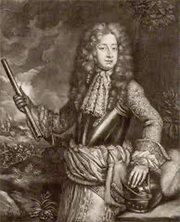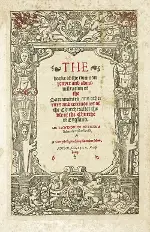King George I of Great Britain and Ireland
Part 1: King-in-waiting George I was King of Great Britain and Ireland for 14 years in the early 18th Century. He was the first of four kings named George. He was originally from Hanover, in Germany, and he and his three immediate like-named successors are known as Hanoverians. 
He was born George Lewis in the city of Hanover, in the German duchy of Brunswick-Luneberg, on May 28, 1660. His father was Ernest Augustus, the Elector of Hanover. His mother was Sophia, the daughter of Elizabeth Stuart and the granddaughter of England's King James I. Young George learned much from his mother, who spoke five languages and was very learned. He learned a handful of languages himself. George first featured in conversations for ruling England in 1680, when King Charles II invited him to England to get to know his daughter Anne (who later became Queen Anne). The two didn't like each other, and George returned to Germany. Two years later, he married someone else. In 1682, George married Sophia Dorothea of Celle, another German duchy; the marriage of the two first-cousins unified the two duchies. They had two children, George (born in 1683) and Sophia Dorothea (born in 1687). They divorced in 1694, and he had her imprisoned. Four years later, George's father died and George became the head of the Duchy of Brunswick-Luneberg. Three years later, George became second-in-line to the throne of England. The 1701 Act of Settlement, precipitated by the death of Queen Anne's only surviving child, William, Duke of Gloucester, declared that George's mother, Sophia, was the heir to the throne. Queen Anne named George to the Order of the Garter. George later fought in the War of the Spanish Succession, in the coalition that opposed France. (He was a distinguished soldier, having also fought in the Great Turkish War in 1683.) In 1714, Queen Anne died. Sophia had died just two months before, so her son became King George I. 
The 1701 Act of Settlement was declared specifically to ensure that the throne of England continued to be occupied a member of a Protestant
religion, not a Catholic. Tensions over religious beliefs had been high in England for nearly 200 years, after King Henry VIII broke with the Catholic Church and declared himself head of the Church of England. Henry's son and successor, Edward I, had presided over a strong embrace of Protestantism, including the introduction The son of James II, also named James, was still alive and still very much convinced that he should be King of Great Britain. Others who also thought themselves more qualified than a German prince to rule England included several descendants of Charles I. In all, a few dozen members of various royal families could present "better" claims to the throne than the one George had. But George had the law on his side, and so he became king. Next page > On the Throne > Page 1 2 |
|
Social Studies for Kids
copyright 2002–2025
David White



 of a Book of Common Prayer and a number of laws requiring people in England to ascribe to Protestant beliefs. The next English monarch, Edward's sister
of a Book of Common Prayer and a number of laws requiring people in England to ascribe to Protestant beliefs. The next English monarch, Edward's sister  was not at all willing to declare the Church of England the effective sole faith of the realm. He wanted Catholics to have more rights and more of a public ability to worship the way that they wanted to. Parliament did not agree with such measures, and James dissolved Parliament. He then appointed known Catholics to high-ranking posts within the government and the military. He went a step further in 1687 by issuing a Declaration of Indulgence, which granted complete religious toleration. The following year, James had a son, seeming to guarantee yet another Catholic on the throne of England. A group of Protestant nobles had had enough of James and his favoritism toward Catholics, and they saw in the king's son a succession of Catholic monarchs. The solution, as these nobles saw it, was to find another monarch, one who wasn't Catholic. As it happened, James had an older daughter, named Mary, who had married William of Orange, a Protestant prince of the Netherlands. This led to the
was not at all willing to declare the Church of England the effective sole faith of the realm. He wanted Catholics to have more rights and more of a public ability to worship the way that they wanted to. Parliament did not agree with such measures, and James dissolved Parliament. He then appointed known Catholics to high-ranking posts within the government and the military. He went a step further in 1687 by issuing a Declaration of Indulgence, which granted complete religious toleration. The following year, James had a son, seeming to guarantee yet another Catholic on the throne of England. A group of Protestant nobles had had enough of James and his favoritism toward Catholics, and they saw in the king's son a succession of Catholic monarchs. The solution, as these nobles saw it, was to find another monarch, one who wasn't Catholic. As it happened, James had an older daughter, named Mary, who had married William of Orange, a Protestant prince of the Netherlands. This led to the 
